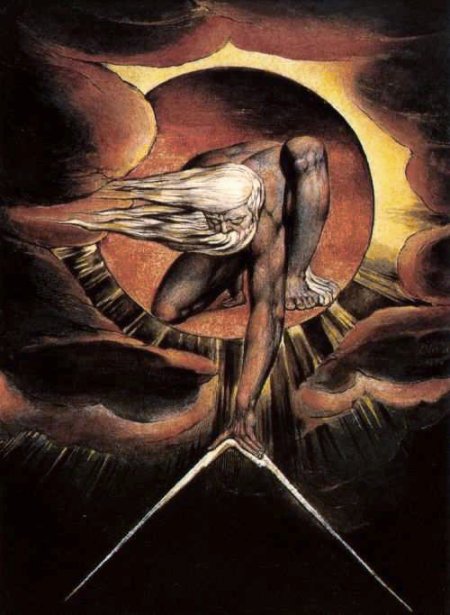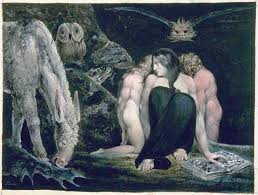1. Blake as a Mystic
Blake's visionary and poetical talents also blossomed early. When returning home from the hills round Dulwich, he saw a tree filled with angels and was barely saved by his mother from a flogging when his father assumed he was lying.
When his brother John died, Blake records how he beheld his spirit ascending and 'clapping its hands for joy'. Thereafter, Blake claimed to hold contact with his spirit 'daily and hourly'; he heard 'his advice and even now write from his Dictate.
2. Blake as a Radical
His acquaintance with Thomas Stothard was eventually to lead to an introduction to the most famous sculptor in Europe, John Flaxman, who became Blake's staunchest friend. Flaxman's coterie were strong supporters of political reform, Flaxman and the artist George Cumberland being members of the Society for Constitutional Information. Blake himself participated briefly in the Gordon Riots of 1780 when he was supposedly 'forced to go in the very front rank and witness the destruction of Newgate [prison].'
In 1800, Flaxman introduced him to the poet and patron of poets, William Hayley . Hayley was impressed enough to have Blake engrave illustrations for a biography of the poet William Cowper while providing him with a cottage by the sea for three years. Towards the end, however, Blake grew increasingly frustrated by his lack of artistic independence and decided to leave.
This decision was complicated by an incident which took place in his garden as Blake pushed off a drunken soldier when the latter refused to leave. Consequently, Blake was charged with sedition and tried before the Chichester courts.
3. Blake's "illuminated painting/relief etching"
"First the notion that man has a body distinct from his soul is to be expunged: this I shall do by printing in the infernal method by corrosives, which in Hell are salutary and medicinal, melting apparent surfaces away and displaying the infinite which was hid." (Blake, The Marriage of Heaven and Hell)

In the 1780s Blake began experimenting with a way of combining his poems and his pictures through a form of colour printing. He was not the only person to have experimented with these ideas at this time, but the solution he reached was one of intriguing beauty and great originality.
Conventional etching depends on the design being etched into the copperplate (intaglio). Blake, however, decided to reverse this method by etching in relief, that is to say, he etched away the background and left the image and text standing up in relief, as in a woodcut.
To do this he used an acid-resistant liquid and drew and wrote, composing directly onto the copperplate (with brushes and a quill pen). When the acid-resistant liquid dried and hardened, the plate would be exposed to acid which etched away the uncovered parts of the copper. Because printing always reverses the design, the text had to be written backwards, and slanted appropriately, in order to appear the right way round when printed.
Writing in this way may appear to be a daunting prospect but, as an experienced reproductive engraver, Blake was well trained in the skill. The plates were then inked with one or more colours and printed under light pressure in an etching press. Not only were the raised parts of the copper plate inked, the shallow (etched-away) areas could also be dabbed with colour and printed simultaneously. The sheets were subsequently hand-coloured with watercolour washes by Blake or his wife Catherine.
4. The Songs of Innocence and Experience

The Songs of Innocence and of Experience is an illustrated collection of poems by William Blake. It appeared in two phases. A few first copies were printed and illuminated by William Blake himself in 1789; five years later he bound these poems with a set of new poems in a volume titled Songs of Innocence and of Experience Showing the Two Contrary States of the Human Soul.
"Innocence" and "Experience" are definitions of consciousness that rethink Milton's existential-mythic states of "Paradise" and the "Fall." Blake's categories are modes of perception that tend to coordinate with a chronology that would become standard in Romanticism: childhood is a state of protected innocence rather than original sin, but not immune to the fallen world and its institutions.
This world sometimes impinges on childhood itself, and in any event becomes known through "experience," a state of being marked by the loss of childhood vitality, by fear and inhibition, by social and political corruption, and by the manifold oppression of Church, State, and the ruling classes.
5. The Marriage of Heaven and Hell

It is a series of texts written in imitation of biblical prophecy but expressing Blake's own intensely personal Romantic and revolutionary beliefs.
The work was composed between 1790 and 1793, in the period of radical foment and political conflict immediately after the French Revolution. The title is an ironic reference to Emanuel Swedenborg's theological work Heaven and Hell, published in Latin 33 years earlier.
The book is written in prose, except for the opening "Argument" and the "Song of Liberty". The book describes the poet's visit to Hell, a device adopted by Blake from Dante's Inferno and Milton's Paradise Lost.
6. Blake's universal mythology in his "Minor Prophesies"
Europe(1794)
The First Book of Urizen(1794)
The Book of Los((1795)
The Book of Ahania(1795)
"In these poems Blake examines the fall of man. In Blake's mythology man and God were once united, but man separated himself from God and became weaker and weaker as he became further divided. Throughout the poems Blake writes of the destructive aspects of this separation into warring identities."(Dictionary of Literary Biographies 93, pp.29-31)
Urizen: representing "reason" that part of mind that constantly defines and limits human thought and action.

Los: Poetic Genius, divided from Urizen representing the part of the human mind forging the creative aspects of the mind into works of art.

Enitharmon: Los's female form after it's separation into a male and a female forms. She gives a birth to Orc who gives some hope for radical change in a fallen world.

Orc: the coming of Orc is likened not only to the fires of revolution sweeping Europe, but also to the final apocalypse when the "Grave shrieks with delight."

Ahania: Urizen's female form after his further division into male and female.

7. Blake's Biography on Youtube: The South Bank Show on William Blake narrated by Peter Ackroyd(aired on September 17, 1995)
A wonderful documentary on William Blake from a contemporary point of view including many interesting scenes where an actor playing the role of Blake is reciting quite a few memorable passages of Blake's works and interviews with an industrialist, the poet Allen Ginsberg, and a biologist all of whom are testifying a strong relevance of Blake's vision to the contemporary life in the Western world.